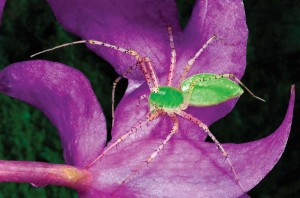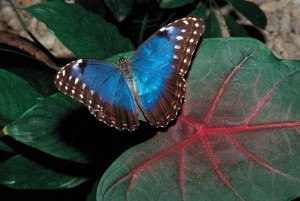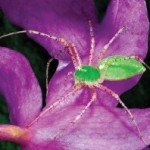Small Is Huge
We often overlook the fact that our planet’s ecology is totally dependent upon the health of these teeming hosts of creatures numbering in the billions.
I would like to take this opportunity to say a few words on behalf of all the “little guys”—all the little creatures that make up the vast majority of the Earth’s animal life. If we were to weigh together every creature on Earth—the zoological biomass of the planet—we would discover that more than 90 percent is made up of insects.
If we add to that the other small and tiny species of worms, nematodes, tardigrades and others, the percentage would rise to more than 99 percent. On Earth, small is truly huge. The big animals, like tigers, tuna, shrews and humans, members of the vertebrate phylum Chordata—literally meaning creatures with spinal cords—are in the verysmall minority. We often overlook the fact that our planet’s ecology is totally dependent upon the health of these teeming hosts of little ones numbering in the billions.
The largest group (order) of animals on Earth is the Coleoptera or beetle, most of which live in the tropical rainforest canopy. Entomologists studying the diversity of the tropical forest shine bright lights up into the trees at night and wait for bugs to descend, knowing that chances are good they will discover new, unidentified species to name after themselves. Only a small percentage of the totality of these insects has been identified. Estimates vary between 10 million and 100 million total species. Many of these arespecialized pollinators and are crucially important for the survival of countless plant species. Each individual is part of a huge interconnected ecosystem, each element playing a role dependent upon many other elements all working in concert creating the symphony of life. Should any part of the global body suffer, so does the whole body.
Conservation campaigns usually focus on endangered vertebrates like jaguars, pandas, elephants and quetzals because people identify more with warm, fuzzy, big animals. But we can be sure that every time a new swath of forest is put to the torch and cleared for cropland and cattle ranching, that many, many species of the little ones become extinct. We are conducting a dangerous experiment upon our home planet by dismantling the incredible diversity of life, each species like a thread in a vast tapestry whose functioning we are only beginning to understand.
We are dependent on many other species and any failure of one part of the ecosystem can create a domino effect.
No one knows how much can be destroyed before we upset the balance. Every creature seems to play a role, even parasites serve a purpose. We are just beginning to understand the beneficial symbiotic relationship between the human body and certain bacteria. We are dependent on many other species and any failure of one part of the ecosystem can create a domino effect, causing disruption throughout the entire chain of life.
What we do know for sure is that more than half of all the temperate and tropical forests are gone, half of the wetlands and a third of the mangroves are gone, an estimated 90 percent of the large predatory fish are gone and more than 20 percent of the world’s coral reefs are dead. Perhaps the time has come to think about preserving some of nature before it is too late.
S.O.S. GUATEMALA: YOUR RAIN-FORESTS ARE ENDANGERED!
At the present rates of growth the world economy will quadruple in the next 50 years or less, and the human population continues to increase. This is a very real predicament for Guatemala, which has the second-fastest growing human population, after Haiti, in the Americas. Haiti’s forests have been almost completely decimated and that is a major factor causing this Caribbean nation to be an economic and ecological basket case.
So, we call upon Guatemala’s leaders to take this situation seriously—there is no time to waste. At present almost all of the protected forests in Guatemala’s Petén Department have been invaded by land-poor campesinos and the situation is spiraling out of control. (And let me be clear here, I have nothing again the campesinos. A hungry man must find a way to feed himself and his family. What is needed is more employment opportunity so that these poor, largely indigenous, people are not forced to cut down the forest in order to subsist.) Also, illegal logging operates with near impunity nationwide. Needed are visionary leaders who will take the necessary steps to stabilize and reverse these destructive trends.
“If the bee disappeared off the surface of the globe then men would have four years of life left. No more bees, no more pollination, no more plants, no more animals, no more man.” —Albert Einstein.
Scientists tell us that the honey bee is totally responsible for the pollination of over 90 percent of the fruit and vegetable crops worldwide, so it is disturbing to discover that 30 billion honeybees representing one-quarter of the Northern Hemisphere’s population has mysteriously vanished and that 90 percent of wild honeybees in the U.S. have died out. As yet, no one knows for sure the reason why. Possible culprits cited include genetically modified crops, climate change, electromagnetic pollution, especially from cell phone towers, and excessive use of pesticides. As Einstein proclaimed long ago, it would be devastating if we were to lose all our honeybees, since most of our food crops are not self-pollinating. A study in Europe has revealed that the number of wildflowers that depend on pollination has dropped by 70 percent. The entire world,including Guatemala, now faces a decline of native pollinators. Over 100 species of birds and more than 80 mammals that pollinate are considered threatened or extinct by the International Union for the Conservation of Nature and Natural Resources. How many native insect pollinators have disappeared from the Mayan Biosphere Reserve and other Meso-American forests, no one knows, but with more than half of the region’s forests gone, we can be sure that the number must be high, including Guatemala, now faces a decline of native pollinators. Over 100 species of birds and more than 80 mammals that pollinate are considered threatened or extinct by the International Union for the Conservation of Nature and Natural Resources. How many native insect pollinators have disappeared from the Mayan Biosphere Reserve and other Meso-American forests, no one knows, but with more than half of the region’s forests gone, we can be sure that the number must be high.
- Grasshopper
- Entomologists studying the diversity of the tropical forest shine bright lights and wait for the bugs.
- Tardigrade… smaller than a grain of sand
- Hairy caterpillar
- Mayan Stingless Honeybees
- Death of the Rainforest
- Beetles comprise the largest order of animals on Earth
- Morpho butterfly











